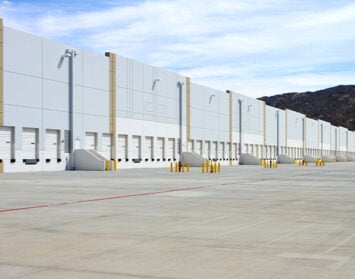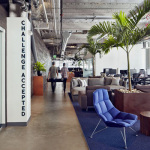Last week I served as a panelist at the InterFace California Commercial Real Estate Trends Conference held in downtown Los Angeles. The overall perspective of the panel was that the economic outlook for Los Angeles, Orange County and San Diego is favorable, although there are some unintended consequences of tax policy and recently passed regulations that could pose big problems in the short term. Here’s a look at the dominant trends in Southern California.
Major Trends: An Overall Favorable Outlook
Existing Businesses Are Driving Growth and Rental Rates
There is tremendous growth, and therefore demand, taking place throughout the state fueled by existing businesses. It is medium sized and large companies, as opposed to a recovery in startup businesses, which are driving the California commercial real estate resurgence. In San Diego, numerous biotech companies have gone public, creating the strongest demand for lab space San Diego has seen in 15 years. Throughout Orange County, Los Angeles and San Diego, tech companies in internet, social media, wireless and electronics continue to be white hot. With consumer demand recovering, sports product companies are creating tremendous job growth as well.
In San Francisco, companies such as Facebook, LinkedIn, Uber, Twitter, and SalesForce.com (which just nabbed another 750,000 square feet) are driving demand for commercial space. The Market Street corridor in San Francisco has seen a wave of real estate developers converting historic buildings to hip space for these tech companies, but with supply being thin, companies are moving into traditional high rises and converting former professional services space into open tech space. On a smaller scale, the same is happening in Los Angeles, with demand for conversion of old, cool brick buildings into hip, trendy, office spaces in areas ranging from selected downtown sites to Santa Monica.
This growth isn’t limited to tech companies. Insurance companies, healthcare companies, and real estate companies are also expanding, resulting in competition for space, and ensuing rental increases. Some markets in California have seen 20-30% rent growth this year to date.
Contraction in Professional Services Will Open Up Entire Floors From Downtown to Century City
We are seeing a major contraction in square footage occupied by professional services industries such as the legal and accounting industries, particularly law firms, from Downtown L.A. to Century City. Law firms are changing the way they do business, with smaller offices and technology driving down the required space per lawyer (no more big libraries filing rooms, and fewer support personnel). Thus the square footage per lawyer is being reduced to 700 square feet per attorney, in contrast to years past where the numbers hovered closer to 1,100 square feet. The end result is that entire floors of space are opening up as law firms reconfigure, or move elsewhere to smaller and more efficient new space.
There are approximately 10 million square feet of office space in downtown Los Angeles and Century City occupied by the legal industry. As these leases are expiring, we are already seeing floors of space being given back. In the aggregate, law firms could give up 2-3 million square feet of space in the next 5 years as they rationalize their interior cultures. With 145 full floors of office space already on the market in downtown Los Angeles, things could get a lot worse in that market as more full floors come available, keeping rents stagnant for many years to come. Meanwhile, in Century City there are over 40 full floors available, but Century City with its diverse tenant base and more desirable location should not suffer the same fate expected for downtown.
Trend in High Density Open Floor Plans Reigns Supreme
As the result of rising rents, many companies are looking increase employee densities in their facilities. But also due to an effort to cultivate unique company cultures, we continue to see a general movement towards open office spaces, ideally with exposed ceilings and low workstation height (or even benching in some tech companies where there are no partitions dividing personnel), to allow for high density. In fact, we are often seeing double the traditional headcount per square foot in workspaces, which for years averaged nearly 250 square feet per person, but are now drifting into the 125-140 square feet per person target occupancy range.
This high-density model is not limited to just creative or tech companies. We are seeing this trend across a spectrum of industries including healthcare, insurance and real estate. While the demand for this creative space has its genesis in San Francisco, it has spilled over into all of the major office markets in Southern California from San Diego to Los Angeles, and this is the way of future for as far as we can see for these industry segments.
Average Credit of Tenants Is High
Unlike in the late 1990s, when startup companies had all of the investors in the world on their side but almost no revenue, today’s tenants are better financed than ever. Companies in the late 1990s raised billions of dollars of venture capital and public money based on business plans and technology that didn’t work. Those companies that survived the “Tech Wreck” of 2000, and then survived the recession of 2008, have come out of the back end with solid products, growing revenues and strong growth based on real businesses. They have earned customers, which brings in revenue and fuels their growth, as opposed to the companies of 15 years ago that fueled growth based on fundraising efforts alone. The strong credit of tenants again gives us reason to be optimistic about the economic outlook in Southern California
Potential Dark Clouds on the Horizon
Minimal Speculative Construction Under Way
There is very little speculative office construction happening at the moment, so we can expect to be facing severe supply shortages in the next 2-3 years, assuming that the economy and job creation continue at their current pace. The reason there is so little speculative construction is that new office projects typically need to be 50% pre-leased in order to get construction financing. With rents still recovering and tenants still able to find adequate second generation office space to meet their needs, there just isn’t a need yet for a lot of new office space. But that’s soon to change if the current rate of absorption continues.
In anticipation, The Irvine Company (which can build for cash on land they own outright) is beating virtually everyone to the punch in several markets. In the UTC submarket of San Diego, The Irvine Company topped out on a new 15-story, 305,000 square foot, Class A building. In Newport Center, The Irvine Company just completed a 21-story, 248,000 square foot building and they just broke ground on another 20-story, 400,000 square foot building in Irvine Spectrum. In the entire Los Angeles region, there is only just over 1,000,000 square feet of total speculative office space under construction consolidated in approximately five projects—a relative rounding error considering the size of that market. Due to this overall shortage of product in the pipeline, we can expect significant upward pressure on rents throughout Southern California for at least the next three years.
Unintended Consequences of Title 24
Title 24, which was enacted on July 1, 2014, has not come without its share of headaches. Designed to force property owners and businesses to become more energy efficient, the regulations are proving costly. Existing light fixtures that are installed in office spaces must be removed in favor of more energy efficient, dimmable LED lighting. The problem is that these fixtures are now in short supply as new tenant improvements, and remodels that require a permit, are required by code to install these new fixtures. They are also about four times more expensive than traditional fixtures.
In addition, all electrical systems may have to be refurbished in existing space to provide for a timer based system that would turn appliances on and off automatically. The cost of removing and replacing these fixtures can add up to 20% more expense on a remodel of space, and 10% for new space. It’s currently a fight in the market about who is going to pay for these increased costs. Landlords are not prepared to just offer higher tenant improvement allowances, yet tenants don’t conventionally pay for building code requirements or expect to pay for any portion of their tenant improvements. The bottom line is that it’s going to cost property owners more to make these conversions, and they are going to try and pass it through to tenants in higher rents, or as capital in existing leases.
That’s not the only concern associated with Title 24. Another problem lies in the enormous amount of waste being generated by the mandated remodels. Light fixtures that are no longer deemed suitable by Title 24, but are still perfectly usable, are being dumped into landfills at an alarming rate. This poses the question as to the cost/benefit of Title 24. Will all of the demolition and reconstruction costs make a measurable dent in energy usage? Will they offset the business cost to property owners (often passed on to tenants)? And will the energy savings justify the environmental cost of so much waste? The benefits remain to be seen, and will be questionable at best.
Increasing Anti-Business Tax Policies and Concerns of Over-Regulation in California
Over the past three years, thousands of businesses have moved their tax entities (or their entire companies) outside of California because of public voting for the passage of Proposition 30, which increased taxes on high-income individuals. It remains to be seen whether this exodus from California will taper off, and what consequences may result if businesses continue to move elsewhere.
Key Takeaways
Overall, the conference concluded with an overwhelmingly favorable outlook for the economy in Southern California. The only clouds on the horizon appear to be the threat of government over-regulation, misplaced environmental protections, and anti-business tax policies. Panelists were optimistic, however, about expansion and growth being good indicators of a healthy economic climate for the immediate future.
David Marino is senior executive managing partner of Hughes Marino, a global corporate real estate advisory firm that specializes in representing tenants and buyers. Contact David at 1-844-662-6635 or david@hughesmarino.com to learn more.











